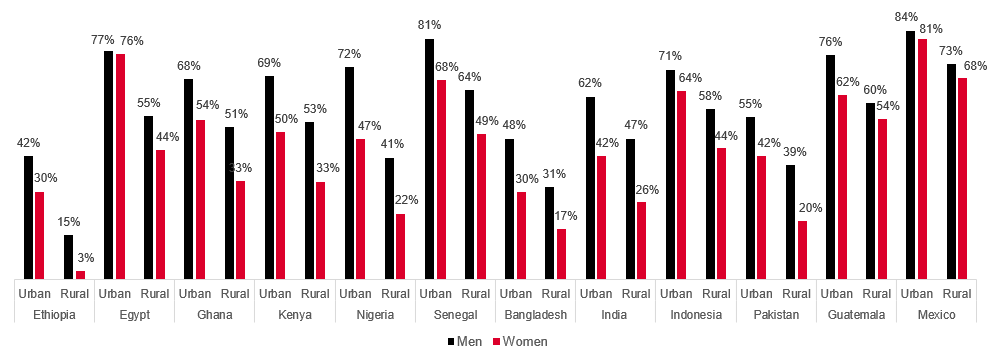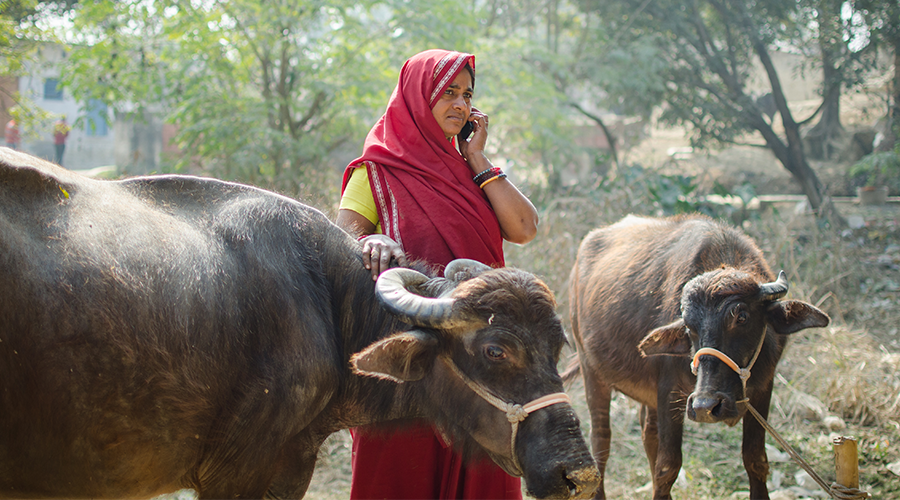15 October marked the International Day of Rural Women to recognise and celebrate their achievements and contributions. With approximately 43% of the world’s population living in rural areas, there are around 1.7 billion rural women and girls globally. Rural women, in particular, are active agents of the productivity and sustainability of households, communities and economies. However, they are being left far behind men and their urban counterparts when it comes to accessing things such as land, credit, healthcare, productive resources and education. The Food and Agriculture Organization of the United Nations (FAO) recent report The Status of Women in Agrifood Systems called the attention to the various sources of inequality that rural women face, from greater food insecurity than men to the gender pay gap, all of which have huge social and commercial implications. Mobile phones have the potential to reduce many of these issues that women disproportionately face, but as highlighted in FAO’s report, GSMA data shows how rural women are last in line in terms of mobile access and use. One year on, based on the most recent GSMA data, across low- and middle-income countries (LMICs) women are 19% less likely than men to use mobile internet, and those living in rural areas are 29% less likely than those in urban areas to do so. Compounded, this means that rural women remain the most digitally excluded.
Rural women remain least likely to access and use mobile technology
Rural women are least likely to own a mobile, own a smartphone and use mobile internet compared to rural men, urban women and urban men in all 12 survey markets (see Figure 1). The resultant gender gaps are also wider in rural areas than urban in all LMICs. For example, in India 62% of urban men and 42% of urban women use mobile internet resulting in a gender gap of 33%. This is compared to 47% of rural men and just 26% of rural women who use it and a rural gender gap of 45% (Figure 1). Wide national-level gender gaps in mobile internet adoption are often primarily driven by low adoption in rural areas; particularly among rural women. This is especially true in Ethiopia where the rural mobile internet gender gap is more than double the size of the urban gap (81% compared to 29%).
Figure 1: Mobile internet adoption in urban and rural areas

At the end of 2022, during the global economic crisis, we asked those who were already using mobile internet whether they had changed how much they use it. Concerningly, women, but especially rural women, were most likely to report having reduced their mobile internet use.
Accessing and embracing mobile technology can pose even greater challenges for individuals residing in rural areas. The hurdles they face are multifaceted and often more pronounced compared to their urban counterparts. For example, there may be fewer opportunities to hear about mobile internet, how to use it and its benefits, either through formal channels or through friends and family, since fewer people in rural areas use mobile internet. Additionally, internet-enabled handsets are less affordable for people living in rural areas, especially women. This is due to multiple reasons – greater transport and logistical costs of distributing devices to rural areas that are passed on to consumers; people in rural areas tend to have lower incomes, especially rural women; rural men and especially women tend to have lower levels of digital literacy which in turn lowers their willingness to pay for an internet-enabled handset. While urban men and women also grapple with issues related to awareness, digital skills and device affordability, these challenges are particularly acute for those in rural locations, especially women. As such, addressing them will disproportionately enable rural men and especially rural women to come online.
Despite these barriers and the wide gender gaps in mobile internet adoption, once rural women do use mobile internet they tend to see the benefits to a similar degree as their urban counterparts. For example, in Senegal, 81% of both rural and urban female mobile internet users reported that it has a positive impact overall on their lives. This suggests that mobile internet can be equally useful to rural women as to her urban and male counterparts.

Why is including rural women important?
As we move towards an increasingly digitised world, excluding rural women and girls threatens to widen existing gender disparities and the urban-rural divide. There is a huge economic opportunity to be harnessed from ensuring rural women’s digital inclusion, directly for the mobile industry and also indirectly for other industries that would benefit from them being connected. Not only this, but closing mobile gender gaps in rural areas will also have huge social benefits whereby millions of women and their families would be empowered and better equipped to deal with shocks. However, realising this potential requires systematically addressing persistent gender gaps in access, knowledge and opportunities. As FAO’s Deputy Director-General Beth Bechdol said, “when we invest in rural women, we invest in resilience”, reminding us that we must focus our attention, action and investment on addressing rural mobile gender gaps, especially amidst the ongoing global crises where resilience is paramount.

The Connected Women programme is funded by the UK Foreign, Commonwealth & Development Office (FCDO) and the Swedish International Development Cooperation Agency (SIDA), and is supported by the GSMA and its members.


